PHOTO TIPS FOR PALAU DIVING
CUTTLEFISH
Text and Photos by Kevin Davidson
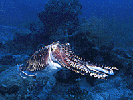 Among the more beautiful and intelligent creatures of the sea is the cuttlefish. Found in Pacific waters, it can be observed and photographed by the scuba diver. It lives at depths accessible by recreational scuba, generally in the range of forty to eighty feet.
Among the more beautiful and intelligent creatures of the sea is the cuttlefish. Found in Pacific waters, it can be observed and photographed by the scuba diver. It lives at depths accessible by recreational scuba, generally in the range of forty to eighty feet.
Classified in the family of cephalopods, it's relatives are the squid and the octopus. Although they are not considered the most highly evolved of the cephalopods, they are extremely intelligent. While observing them, some wonder who is doing the observing, the diver or cuttlefish.
Masters of Camouflage
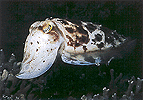 Their ability to change color or direction in a split second is rivaled only by other cephalopods. A small jet located just below the tentacles can expel water to help them move. A ribbon of highly evolved flexible fin on each side of the body, allows the cuttlefish to hover, move, and stop. They blend in with the surrounding environment by changing colors, making them the master of camouflage.
Their ability to change color or direction in a split second is rivaled only by other cephalopods. A small jet located just below the tentacles can expel water to help them move. A ribbon of highly evolved flexible fin on each side of the body, allows the cuttlefish to hover, move, and stop. They blend in with the surrounding environment by changing colors, making them the master of camouflage.
The cuttlefish has ten arms, two of which are specialized feeders and its mouth is beak like, much like a parrot fish. This enables them to capture crustaceans with their powerful arms and crack shells with their strong beak type mouth.
Cuttlefish Communications
They have no outer shell but do have a back bone. Their skin is covered with small sacks, or chromataphors, which enable them to display many different patterns of color. Like the squid and octopus they are able to match their surroundings to avoid predators. Studies have shown that cuttlefish have a body language all their own. Through a highly elaborate series of arm movements and color changes, the cuttlefish can communicate with each other. Divers who witness this are mesmerized by the activity, which is why the cuttlefish is such a captivating animal to photograph, video or just observe.
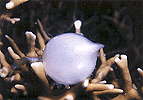 Mating
Mating
Like other animals cuttlefish go through an unusual display of mating rituals. Males will splay their arms and use every color they have to impress the female. When the two are ready to mate, they lock arms and the male passes the female a sealed pack of sperm. Even after a transfer takes place, another male cuttlefish may try to fight for his chance to mate with the female. If another male can take over he will lock arms with the female who already has a sperm pack inside of her and flush out the female cavity with water. He'll then insert his own sperm pack and take his turn at guarding the female from others.
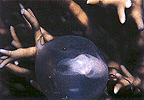 The female uses her arms to guide the egg in to the fire coral where it is secured until ready to hatch. The eggs are just slightly smaller than a ping pong ball and are about the same color. In other locations in the Pacific cuttlefish eggs have been found in the roof of a cave. Here in Palau I have located these eggs in a mound of thin finger fire coral. As the egg matures it becomes clear and you can see the young cuttlefish inside a small yolk sack. When the young cuttlefish is ready to come out, it finds the thinnest area of the egg, which is slightly stronger than a water balloon and pushes it's way out.
The female uses her arms to guide the egg in to the fire coral where it is secured until ready to hatch. The eggs are just slightly smaller than a ping pong ball and are about the same color. In other locations in the Pacific cuttlefish eggs have been found in the roof of a cave. Here in Palau I have located these eggs in a mound of thin finger fire coral. As the egg matures it becomes clear and you can see the young cuttlefish inside a small yolk sack. When the young cuttlefish is ready to come out, it finds the thinnest area of the egg, which is slightly stronger than a water balloon and pushes it's way out.
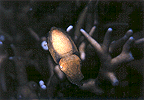 Immediately upon hatching the cuttlefish has all the traits of an adult and is able to feed and fend for itself. The number of eggs laid by a female varies, but is in the range of about twenty to thirty.
Immediately upon hatching the cuttlefish has all the traits of an adult and is able to feed and fend for itself. The number of eggs laid by a female varies, but is in the range of about twenty to thirty.
Cuttlefish tend to be territorial so once you spot one returning to the same dive site, finding them again is usually easy. These captivating and beautiful creatures are just one of the many reasons that scuba diving is such a fascinating sport.
Underwater Digital Photography Online Courses
Web Site Design | Photography | Destination Info | About Us | News & Events | Site Map | Search | Home | Copyright
 Among the more beautiful and intelligent creatures of the sea is the cuttlefish. Found in Pacific waters, it can be observed and photographed by the scuba diver. It lives at depths accessible by recreational scuba, generally in the range of forty to eighty feet.
Among the more beautiful and intelligent creatures of the sea is the cuttlefish. Found in Pacific waters, it can be observed and photographed by the scuba diver. It lives at depths accessible by recreational scuba, generally in the range of forty to eighty feet.
 Mating
Mating
